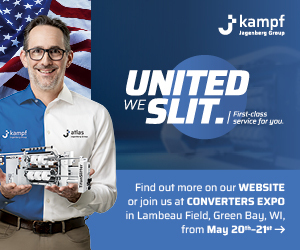Tissue converter accrues benefits of AC servo drives
- Published: October 01, 1995, By Simonsis, Yolanda
Wepa & Co., a German tissue converter, discovers firsthand the advantages afforded by electronic line shafting on its new C.G. Bretting converting machinery. The heart of control resides in software within an Indramat digital AC servo drive and a plug-in CLC control card.
Purchasing equipment that is first of its kind for a machinery manufacturer has some inherent risks. But some risks are worth taking. Family-owned Wepa & Co., a German facial tissue converter, felt confident in its purchase of C.G. Bretting's (Ashland, WI) first electronically controlled tissue converting machinery. The new equipment represents Bretting's first effort in adopting electronic line shafting (ELS) for its machinery after employing mechanical line shafting for the past 60 years. The switch has yielded a number of advantages to the converter.
Wepa & Co. was founded in 1948 and presently employs about 800 with plants in Arnsberg and Marsberg, Germany. It is considered medium-sized, but there's nothing medium about its products, including more than 100,000 tons of hygienic paper per year. Wepa is reportedly the leading German manufacturer of assorted recycled toilet paper made of 100% waste paper. The company's environmental commitment is emphasized by its support of the Kinder-Umwelt-Klub International, better known under the acronym K.U.K.I. (Children, Environment Club International). Emil Grunbar (green bear) is the organization's symbolic figure.
Among Wepa's many products are brands that are "mach mit" - recycled tissue, hygienic paper made of 100% waste paper without any bleaching agents or coloring matter. Clou is a one-ply, crepe hygiene paper, also without bleaching agents or coloring matter. (The preceding products are distinguished by the Environment Jury with awards called "Environment Angels.") Sammy is a multi-ply, hygienic white tissue paper. The company also makes several private label brands.
The seven-axis Bretting equipment purchased by Wepa includes an Indramat (Woodale, IL) digital AC servo drive and plug-in CLC (computer-logic card) multiaxis coordinated motion control card that downloads parameters and precisely synchronizes all seven axes. Electronic line shafting eliminates the need for a mechanical drive train by electronically controlling the velocity, position and torque of individual stations while synchronizing all operations on the machine.
Since the Wepa purchase is a large and multisectioned machine, ELS control provides many benefits. For Wepa, electronic coupling has slashed the need for many mechanical components and related parts inventory. It also eliminates the downtime caused by wear of mechanical drive trains. Another benefit is that the machinery takes up less floor space and has a simple machine layout that permits easy access for routine maintenance.
High-Performance Delivery
The first axis of the seven-station Wepa tissue converting machinery is a rear unwind stand that can handle up to 108-in. parent rolls. It is driven by a surface belt through a gearbox by a 3,000-rpm Indramat digital AC servomotor with a 100-amp amplifier. To keep the proper tension on the tissue paper, an analog proximity sensor located at the unwind dancer signals the Indramat CLC motion controller to "trim" the tension and feed rate of the tissue paper.
At axis two, the tissue paper is pulled through a pair of "pull rolls" driven through a gearbox by a 3,000-rpm Indramat digital AC servomotor using a 50-amp amplifier. The tissue paper is pulled through a slitter, which cuts the paper in half, and it's then pulled at a right angle across two turn bars. The two halves are combined and precisely aligned across several rolls to create a wrinkle-free, two-ply tissue.
Axes three and four are the front unwind stand and front turn station - essentially duplicates of the first two axes. These stations are always used for single- and two-ply tissue. When manufacturing single-ply tissue, the first two stations are simply turned off by a selector switch in the control cabinet.
The calender section is next, using compression rolls to soften the paper. The upper calender station (axis five) compresses the paper from the rear unwind and turn station; the lower calender (axis six) compresses paper from the front unwind and turn station. The degree of compression is determined by the type of paper and characteristics of softness required. Thus, the system is designed to be responsive to the different tensions needed to properly control the feed rate of the paper to the folder section of the machine. To do this, the operator has the capability, through a "trim" switch, to increase or decrease the speed of each of the 3,000-rpm Indramat motors at the calender section to exactly match the proper tension desired.
Because the system is designed to act as a closed-loop response system, any speed tension change required from one servomotor will automatically signal the CLC motion controller to direct the other servomotors to also compensate for this change. The system is thus able to maintain the proper paper tension throughout the machine.
All through this process - and even during fast 3-sec. stops - electronic coupling reportedly maintains torsional stiffness between the stations as well as the precise tautness that is required in the final tissue product.
The seventh axis drives the final folder, using a 3,000-rpm digital servomotor with a 150-amp amplifier. This section comprises seven slitting knives; five slitting knives cut the single roll of tissue into six smaller webs that are sized for boxing, and two knives trim each of the two outside edges. From there, the tissue is perforated, folded and pulled onto a transfer table for boxing.
Design Flexibility
Because of the customized design of each Bretting machine, Wepa, like other tissue converters, is able to achieve design flexibility without having the machine manufacturer re-engineer their mechanical drive systems as well. Various parameters can be preset, such as gearing, motor ratios and velocities. Then, using icons and answering software-prompted questions in the Windows format, Wepa selects parameters to make changes, enter fine-tuning velocity or phase changes, or bring an entire section on-line or off-line. The ELS software provides the necessary controls and features to eliminate the labor time and material waste that is said to be common with manual mechanical line shafting.
The fact that a German tissue manufacturer had the vision to purchase new technology from a US equipment manufacturer in Wisconsin reveals yet another story about Wepa's level of high confidence in C.G. Bretting's technical expertise.
Typically, one very large DC or AC induction motor (30-75 hp) is coupled via belt to a primary mechanical line shaft that runs the entire length of the machine.
Each auxiliary function has an in-line, adjustable gearbox that allows the machine operator to individually adjust the speed of each function relative to the speed of the line shaft. Using a hand crank, the operator visually lines up his change or views a display that shows the speed change.
To change to a different part or size of end-product, the machine must be stopped for several hours to alter the mechanical setup.
Electronic Line Shafting
Several relatively small servomotors (3-10 hp), controlled by a master position controller, are used to drive each section of the machine. Today, electronic line shafting technology permits control of up to 40 axes with one position controller.
Each auxiliary function has its own AC servomotor. To make adjustments, the operator simply enters the changes on the master control or computer keyboard. An extremely accurate status report is displayed right on the control monitor, eliminating the less accurate approach of "eyeballing" by the operator.
To change to a different part or size of end-product, the machine is brought to a stop for only minutes so that a new software recipe can be loaded.












